SPECIAL ANNOUNCEMENT!
FOA will present a special webinar with Cabling Installation and Maintenance Magazine on November 29 on "5 Ways To Test Installed Fiber Optic Cabling."
This webcast seminar, produced by Cabling Installation & Maintenance and presented by FOA President Jim Hayes, takes a hands-on look at each of these five standard test methods. Attendees will see the physical setup of each method and gain a thorough understanding of each method’s application as well as measurement uncertainty.
5 Ways to Test Installed Fiber-Optic Cabling
November 29, 2012: 1:00 PM EST / 12:00 PM CST / 10:00 AM PST / 6:00 PM GMT
Sign up at http://video.webcasts.com/events/pmny001/viewer/index.jsp?eventid=44642&adid=foa
40,000 FOA CFOTs!
In early October, 2012, FOA registered it's 40,000th certified member. Since its founding in 1995, the FOA has expanded to become the international source of education and certification in fiber optics.
Fioneers : Chattanooga Gig
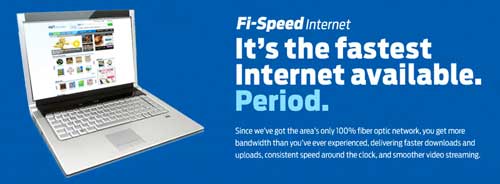
Chattanooga, TN, USA was the first city to get a fully operational gigabit FTTH system – “Fioneers” they call themselves. It was built by EPB, the city electrical utility which buys power from TV and distributes it over a 600 square mile area that includes 170,000 businesses and residences.
The idea for Chattanooga’s system began with their upgrades to their electrical distribution system as part of building a “Smart Grid” system. They expanded to the home to read electrical meters, and since the local phone and CATV providers were not providing state of the art broadband, they decided to offer competitive services. They already had a created CLEC (completive local exchange carrier) offering phone service, so expanding it to FTTH and offering triple-play service was straightforward.
Planning for the FTTH system began in 2007 and installations have taken about 3 years – every one of those 170,000 homes and businesses have access to the best FTTH in the world. The system started with BPON but is now a GPON system with 2 rings, lots of aerial cable (~85%) but also some underground, with ONTs mounted on the outside of homes. Installation was done by contractors but managed carefully by the utility. Contractors even did the installation inside subscribers’ homes. The contractors wore EPS uniform shirts and booties over their shoes to prevent getting the homes dirty. And he electrical meters are connected into the system using Cat 5.
Chattanooga's commitment to creating a world-class communications system has paid off. VW located their US factory there. Major corporations, technology firms and call centers are using their fiber to build their business. Benefiting from unlimited bandwidth, incredible speeds and local, Chattanooga-focused customer service.
The city has become a center for the development of applications that can take advantage of high speed connections.Venture capital firm Lamp Post Group is investing in small start-up companies that have big vision, that are innovating the future. For LPG, fiber is powering smart investment by attracting creative entrepreneurs who are eager to explore what is possible with so much bandwidth. In 2012, they are launching Lamp Post Lab, bringing bright undergraduates from around the country together to explore what can be built using the world’s fastest Internet – with a $50,000 prize for the best idea to get started.
We have often said that the most important issue in a FTTH system implementation is commitment on the part of the community and the system provider. Chattanooga shows that after commitment, one needs two more things – good planning and good management, especially in managing contractors who are doing the work. But one should not underestimate the other incentive - creating a "smart grid" system that offers other advantages to the region.
Well done, you Fioneers in Chattanooga!
Here is the Chattanooga Gig website - required reading for any city contemplating a similar project.
Visit (Virtually) Google Data Centers

Google is opening a virtual window into their previously secretive data centers. Google has created a new website http://www.google.com/about/datacenters/gallery/#/ featuring photos (arty and beautiful, BTW) from inside some of the data centers that Google has in the U.S., Finland and Belgium. Google is also building data centers in Hong Kong, Taiwan, Singapore and Chile.
You might notice that these photos are a lot more than "regular" photographs and certainly not from Google Street View. For those of you interested in photography, PopPhoto, one of the US photography magazines, has an interview with the photographer.
US Broadband Technology Opportunities Program (BTOP) Quarterly Program Status Report
The American Recovery and Reinvestment Act of 2009 appropriated $4.7 billion for NTIA to establish BTOP to increase broadband access and adoption; provide broadband training and support to schools, libraries, healthcare providers, and other organizations; improve broadband access to public safety agencies; and stimulate demand for broadband.1 The Recovery Act also provided funding for NTIA to develop and maintain a comprehensive nationwide map of broadband service capability and availability, and to implement the State Broadband Data and Development Act and the Broadband Data Improvement Act.
From April to June 2012, BTOP grant recipients continued to demonstrate strong performance across the Program’s FY12 goals. These positive results have helped the Program deliver significant progress in areas such as new fiber-optic infrastructure construction, the opening of new PCCs, and thousands of new broadband subscribers now experiencing the benefits of high-speed Internet service. Recipients’ quarterly progress reports, which were made public at the beginning of September 2012, provide a more granular depiction of these results.
BTOP infrastructure projects deploy new or significantly upgraded network miles, connect community anchor institutions, and facilitate enhanced access to broadband Internet services for households and businesses. Increased network miles are a direct indicator of the nation’s growing broadband infrastructure. These expanded and enhanced networks serve as an important building block for more affordable broadband services to homes and businesses and contribute to America’s global competitiveness.
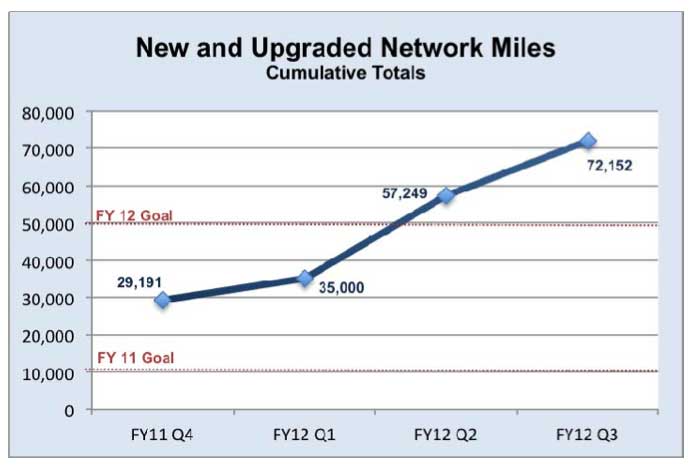
The Program made considerable progress in deploying network miles during this quarter with widespread construction activity occurring during spring 2012. Recipients also continued to lease dark fiber and existing broadband facilities when available. BTOP recipients also exceeded NTIA’s FY12 goal to deploy 50,000 new or upgraded network miles across the country. Recipients deployed nearly 15,000 network miles during the past quarter, bringing the total number of miles to more than 72,000. Through June 30, 2012, recipients were deploying facilities in 47 states and territories.
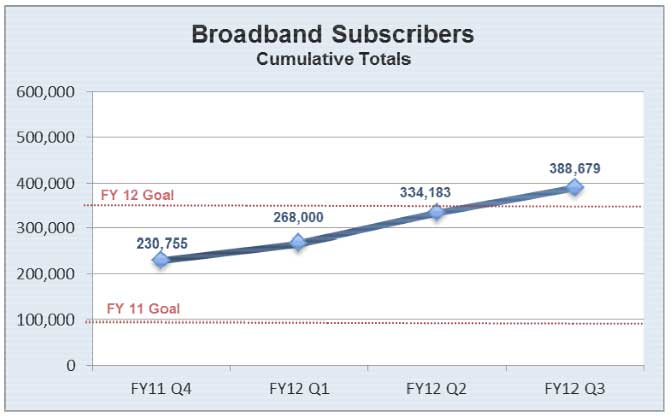
Through June 2012, 34 BTOP recipients reported that more than 380,000 households and 8,000 businesses subscribed to broadband services after receiving digital literacy or job training. New subscribers for the past quarter totaled nearly 55,000, meaning that more Americans are now using the Internet to search and apply for jobs, advance their educational goals, and find health-related information. Nearly 79 percent of SBA grant recipients reported new broadband subscribers. NTIA expects the number of new subscribers to continue to increase as more households complete training programs, receive subsidized computer equipment or broadband service, and take advantage of workstations and discounted subscriptions provided by BTOP funds. BTOP recipients exceeded NTIA’s FY12 goal of 350,000 planned new broadband subscribers.
Read the whole report including descriptions of several of the projects at http://www.ntia.doc.gov/files/ntia/publications/btop_14th_quarterly_report.pdf
The Value Of Training For Network USERS.
The following is a series of questions and answers we exchanged recently with a network manager. It is a discussion of the value of training for those who are not full-time installers.
Subject: Training questions
Q: We are installing a fiber optic network for our system upgrade. I am wondering if it would be worthwhile to invest in the training and equipment required to troubleshoot the fiber optic system in the event of a failure? The concerns are that fiber optics is the most robust piece of the security system and failures would most likely be on the electronics side versus the fiber optic network. Also, the training, if used, would be used so little that the skill level and retention of the training would diminish to the point where it would not be useable.
A: Our experiences confirm you are basically correct. Fiber is highly reliable and if properly installed and secured, should never need maintenance. We recommend secure systems be installed in conduit and all joints (splices or connectors) be inside locked boxes. This is normal procedure for public buildings like convention centers or airports and of course jails.
Q: Our understanding is the fiber optic failures, once the system is fully tested and commissioned, normally come from human error (cut cables) and not from the fiber optic network deteriorating and failing.
A: Yes, that is generally quite true. We find more harm to fiber optic cabling systems comes from untrained personnel who try to clean or patch systems during moves/adds/changes. Construction crews can also do damage, which is why conduit is used in many buildings where crews may be working near the fiber. But having some basic training will ensure that your personnel can work with the fiber and electronics and troubleshoot problems - without causing harm.
Q: Is the skill level required to troubleshoot and maintain systems something that must be practiced on a regular basis to be effective. Our guess is that this is better left to a contractor specializing in fiber optics?
A: Not really. In fact, having some personnel trained in basic fiber optics would make it easier to ensure proper handling and to troubleshoot electronic problems, since it is necessary to decide if it's electronics or cabling. The basic knowledge is straightforward, test equipment is simple and not expensive and if documentation shows what the cable plant test results were, it is easy to confirm it's OK.
Let's make that point again - the contract for installation should require the contractor provide complete documentation as to the layout of the cable plant and test results on each fiber. This is the most important thing for troubleshooting!
The FOA offers online training at Fiber U where you can study online to learn the material using our Online Reference Guide and YouTube videos. This may be enough to ensure that your people are at least informed if not skilled on the issues. If you want hands-on training, you can contact one of the FOA-Approved schools.
Passive Optical LANs - Who Created This YouTube Video Spoof?
Someone created this spoof video which compares POLs with conventional LANs. It's origin is unknown but it makes a pitch for using POLs .
http://www.youtube.com/watch?v=58tyDOr5BRs&feature=youtu.be
The TIA TR.42 cabling committees met in Philadelphia the week of October 1-5 for their regular meeting. Several topics we have been following had significant developments at this meeting.
TIA-568-D Premises Cabling Standard Revision
The TR.42 Chairman announced that plans were being made to start work on TIA-568-D revision. It appears that there will be an effort to have the D revision sections released simultaneously, not in stages as was done with TIA568-C. There is concern that because of the asynchronous release, the C revision was poorly organized and required many addenda in early release documents to correct topics that were modified in later documents. This has made using 568-C very difficult for those concerned with configuration control in their documentation and hard to understand for all.
Copper Cabling: Cat 8?
Yep, forget Cat 7, let’s go straight to Cat 8. Concerns over bandwidth may limit distances to < 50m and alien crosstalk may require shielding. It’s very early to draw conclusions on where this is going. We suggest you read the writeup from one manufacturer, Siemon, and even read the links to some IEEE papers in their article. http://blog.siemon.com/standards/next-generation-ieee-base-t-study-group-contribution-suggests-shielded-cabling-as-the-better-choice
Fiber Optics
Encircled Flux (EF)
EF continues to be a major topic at TIA meetings and is likely to remain so. At the Philly meeting, preliminary results of an industry round-robin to determine if labs could test EF consistently were presented. These results were sufficiently consistent to convince the originators of EF that measurements were possible to correlate, not just between various labs but also from various measurement techniques. While many thought this would be the end of the investigative phase, the next requirement – a transfer standard needed to ensure that labs were able to determine when a source met the standard – is much more technically difficult. Even if the labs could agree on their measurements, that does not mean that they know what an EF source looks like without a transfer standard.
Several of the supporters of EF have suggested limiting the scope of EF to 50/125 fiber for high speed applications. At the meeting, as task group was created to change the preface of the new OFSTP-14 based on ISO/IEC 61280-4-1 to limit the applicability of EF, probably to OM3/OM4 fibers and high speed systems and maybe to 850 nm.
Work continues on the TSB covering how to use EF. The new 8-page document was presented at the prior meeting to discuss and allow comments. It created some controversy as it got many negative votes and 32 pages of negative comments. The number of negative comments was so large that it was considered impossible to discuss those comments in a regular committee meeting so a subcommittee was created to meet biweekly in teleconference to deal with the comments and report back at the next meeting.
Some other issues with EF were mentioned in the meeting including how repeated matings of an EF complaint source/launch cable to cables under test will affect the modal distribution and how using a “sacrificial jumper” would affect the modal distribution. Another topic is the need for reference quality jumpers with tightly controlled geometry (diameter/concentricity).
So while EF is making progress, it appears that it will be limited in scope and still requires considerable R&D to become a viable method of modal control for OM3/OM4 multimode testing.
FOA Guide to Encircled Flux
Bend-Insensitive Multimode Fiber (BIMMF)
Another meeting dealt just with bend-insensitive multimode fiber. BIMMF has been a continuing topic as tests show splicing or connecting it to regular MMF can cause bidirectional loss differences sufficiently high to cause concern with high bitrate systems that have very low loss budgets. It seems that other measurements of BIMMF are also causing concern, including how to measure numerical aperture (NA) and bandwidth. The fiber structure near the outside of the core near the wells that provide for bend-insensitivity may cause problems with higher order modes, affecting bandwidth of the fiber. BIMMF also needs much more R&D to answer these questions. It almost makes you wonder if it’s worth it.
FOA Guide to Bend-Insensitive Fibers
Multipath Interference (MPI)
Multipath interference refers to the reflection of signals between two reflective points like connectors in a cable plant. Multiple reflections can cause high speed signals to degrade by affecting pulse shape or reducing the signal to noise ratio which may affect bit error rates. This can be a concern with both SM and MM systems. It is being investigated in several international standards committees.
Another Nomenclature Change (GROAN!)
It seems the international standards groups are weighing in on the hybrid/composite cable definitions again. The US NEC says a cable with fiber and electrical conductors is a composite cable and a cable with two types of fiber (usually SM/MM) is a hybrid cable. ISO/IEC now says a hybrid cable is a cable with fiber and conductors.
We have many references in FOA documents that may need to be changed, but its so confusing, we will probably resort to saying “When you see or hear the term “hybrid” cable, ask what it is supposed to mean!”
Thought of the month...."Why are we creating standards for today's networks based on 30 year-old data from a survey of a limited number of PBX users?" Remember LANs were just in their infancy then.

In our continuing quest to help people understand how to test fiber optic cable plants and communications systems, we've created a "QuickStart Guide to Fiber Optic Testing." It's a simple, step-by-step guide on how to test fiber optic cable plants, patchcords or single cables and optical power from transceivers. It's as straightforward as it can get - what equipment do you need, what are the procedures for testing, options in implementing the test, measurement errors and documenting the results.
It can't get much simpler.
Send anybody you know who needs to know about fiber optic testing here to learn how it's done in a few minutes.

New FOA Lecture
We've added a lecture on a new topic, the characterization of optical fibers for CD, PMD and spectral attenuation, important issues for long haul systems and DWDM.
FOA Lecture 28, Fiber Characterization
We also added a Premises Cabling lecture on counterfeit Cat 5 cable, with a demonstration of its flammability.
Premises Cabling Lecture 11: Counterfeit Cat 5 Cabling
2 New "Hands-On Hints" Videos:
We've added two "hands-on" videos with hints on using OTDRs and microscopes for visual inspection. Watch for more hands-on videos.
Using an OTDR
Visual Inspection of Connectors With A Microscope
That's Entertainment: Lady Gaga's Fiber Optic Wig

Lady Gaga has unveiled her latest look: A peroxide blonde wig that lights up like a Christmas tree (or like the LED-light dress we fully expect her to wear with this). In a YouTube vid, the singer explained, "The wig is made out of a mixture of real hair and the finest fiber optics in existence; they move and feel like real hair." According to Gaga, it took over six months to gestate this Haus of Gaga Artpop creation, "inspired by taking a Disney princess and putting her in a rave." Natch! (Incidentally, you can buy fiber-optic extensions for raves; they're all over amazon.com and turn on via a hair clip.)
The tech specs: When the lights are off, the wig looks like any hairpiece; Gaga's fiber-optic strands are not obvious. The wig can be plugged into a generator and also into Gaga's lighting board onstage, so that the lighting director on her "Born This Way Ball" tour can control its glow.
Want a cheaper version for your Halloween costume? Try Amazon.
Note: We assume most of these wigs are made of plastic fiber, but if it's glass, please use caution!
Alcatel-Lucent Adds Integrated OTDR Capabilities To Transceivers
Alcatel-Lucent is testing a new concept that adds OTDR capability to transceivers for use in deployed systems. Initial applications are focused on PONs and will integrate with the Alcatel-Lucent network monitoring systems. Bell Labs developed the technology which will be licensed to transceiver manufacturers.
From Lightwave
US Coast To Coast, 8Tb/s Using WDM at 100Gb/s
See what private fiber networks can be. http://www.zayo.com

A Guide to Europe’s Tech Hubs
(From the Washington Post)
Europe may not have the go-for-it startup ethos that characterizes Silicon Valley but there are still a dozen or so pockets of high-energy, high-tech expertise on the continent. From London’s expanding Tech City to Silicon Glen, and from Tallinn, Estonia, to Berlin, here’s the Washington Post's guide to European’s hottest tech hubs.
http://www.washingtonpost.com/business/technology/a-guide-to-europes-tech-hubs/2012/10/16/c1cf05be-16f6-11e2-a346-f24efc680b8d_story.html?wpisrc=nl_tech
2012: The Year of The OTDR
Most of the technical and testing questions we get here at FOA involve misunderstanding of OTDR testing. A number of FOA master instructors have suggested we focus on OTDR training, both in our schools and online, to minimize the problems, so we have declared 2012 "The Year of The OTDR." Look for special articles, a new "1pStandard" and other information that will make these instruments less enigmatic!
OTDR Questions
This month, we'll answer some of your questions.
Q: I am testing a cable with OTDR. I have a limit 0.2 db loss per splice. I use bi directional analysis. In some fibers from A>B direction i have 0.25 loss but in B>A it doesnt show up that splice at all. I changed the pulse width but nothing happened. Any ideas?
A: You are seeing the directional differences. For a splice with 0.25 dB loss in one direction and 0 dB in the other, the average is (0.25+0)/2 = 0.13 dB loss. If you shoot in both directions and overlay, the software should recognize that there should be events in both directions, input a "0 dB" event and average accordingly. Most OTDRs also allow setting a threshold for detection of events and that must be set correctly to recognize events. There are many times a splice is undetectable in an OTDR trace due to good splices and the simple fact that the OTDR measurement technique itself is limited.
Q: How can we differentiate a ghost from a real event?
A: A ghost will not have any loss, it will be at equal distance from a highly reflective event (look for repetition), tends to be in the middle of noise after the end of the cable.
OTDR FAQs
Including FOA Master Instructor Terry O'Malley's tests on what the end of a fiber trace looks like with broken and cleaved fibers.
Frequently Asked Questions On OTDRS And Hints On Their Use
Three Good Practice Tools For OTDRs, All Free
You may already know that the FOA has a free OTDR Simulator you can download from our website (go here for directions) that allows you to practice using an OTDR on your PC, seeing the effects of changing setup parameters and analyzing dozens of real world traces. But here are two more tools that can be good for practice.
AFS OTDR Online Demo
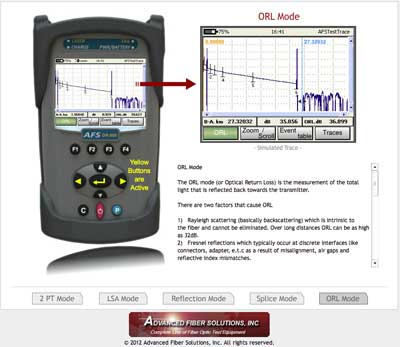
AFS has an online interactive demo of their new OTDR that allows you to see how an OTDR makes measurements. You use the yellow buttons in the center of the OTDR to set the markers to make measurements. Very well done. Go to http://www.afsi.us/otdr/otdr_mode.php for the demo.
"Fiberizer" APP Reads, Analyzes OTDR Traces

Fiberizer is a iPhone/iPad APP that reads industry-standard ".sor" format files and allows trace analysis on your iPhone or iPad. An android version is in the works too. Read more about Fiberizer. And here are more directions on its use.
Events of Interest
FOA Gives Webinar on Cabling Project Planning And Installation For CI&M Magazine
Topic: Cabling Project Planning - The Customer's Point of View
This webcast seminar was presented by FOA President Jim Hayes. In the seminar, Hayes will explain what is involved in a cabling-installation project (fiber, copper and/or wireless), from concept to acceptance. He will describe the step-by-step procedures, referencing which responsibilities fall on the end user, which fall on the contractor, and the critical points of cooperation between the two.
You can watch this seminar on your PC or Apple iPad or iPhone.
The seminar is archived on the Cabling Installation & Maintenance Website.

FOLS Webinar
Testing for Data Centers
Presented by Michelle Collier, AFL
Today's high speed networks require more stringent performance than typical LANs. To be sure the networks will support today's networking applications it is important to properly clean, inspect and test optical fiber networks. This webinar will address which tests are required and recommended and how to perform them.
Thursday, October 4th from 11:00 a.m. to 12:15 p.m. EST
Available on demand.

The economic impact of advanced broadband networks on a city and the entire region
THIS IS THE FIRST conference of its kind in this country - an event devoted entirely to the relationship between a community's economic vitality and the presence of advanced broadband networks. Nations around the world have recognized this powerful linkage and responded to it - as have a growing number of communities in the United States. Each event in this new conference series will be held in a city with an advanced broadband system. Each event will have an impressive array of speakers whose mission will be to help attendees evaluate the options and opportunities and develop the optimal, affordable solution for their communities. The first conference is in Danville, Virginia - the Comeback City that bounced back from devastation with a visionary broadband strategy that's creating jobs and attracting the businesses and industries of tomorrow.
More info.

9- 12 December in Abu Dhabi
The inaugural Fibre Optics in Energy Conference 2012 taking place from 9- 12 December in Abu Dhabi will provide a platform for industry leaders to share knowledge, experiences and practical solutions on use of Fiber Optics in the energy businesses.
AFL to Host "Traveling" Advanced Splicing Seminars
AFL has launched advanced splicing seminars intended for engineers and professionals, as well as university students, engaged in fiber optic activities involving non-standard and specialty fusion splicing activities. Typical applications for these advanced splicing needs are often in the Medical, Oil and Gas, Fiber Lasers, Optical Manufacturing, and Aerospace markets. These seminars will cover a wide range of applications and solutions for difficult and challenging applications using advanced fusion splicing platforms.
- Seminars will be held in around the US and Canada.
- There is no charge for attending; however AFL will be conducting pre-registration in order to ensure availability of a proper facility depending upon the number of attendees.
- Details on the seminar, a current schedule and signup form are at http://www.stateofthearc.com/seminars/signup.html
Free Corning "See the Light" Seminars
Corning Cable Systems' See the Light team is coming to a city near you! Receive Free fiber optic training on a variety of topics including Termination Technology, Testing and Trouble Shooting, Fusion Splicing, and Preterminated Solutions. These interactive three-hour sessions provide students with a comprehensive overview of the latest technology. Fiber optic BICSI (CEC) credits apply (3).
Here is the current information and schedule.
JDSU Testing Webinars
You are invited to join JDSU for a complimentary series of educational webinars. Each webinar, presented by a JDSU subject matter expert, lasts approximately one hour, including Q&A.
Go here to see the seminars offered. IMPORTANT: use registration password: FONA1.
Don't forget to download your copies of the JDSU Testing Textbooks.
 What's New @ FOA What's New @ FOA
FOA Standards For Contractors, Designers, Installers and Users
Read more about them here. And above.
Go to the FOA "1 Page Standards"
FOA Certifications Recognized By US Department of Labor

All FOA Certifications have now been recognized by the US Department of Labor. The DoL reviews certifications and how they relate to job opportunities and training. The DoL Career OneStop website helps individuals explore career opportunities to make informed employment and education choices. The Web site features user-friendly occupation and industry information, salary data, career videos, education resources, self-assessment tools, career exploration assistance, and other resources that support talent development in today's fast-paced global marketplace.
FOA Certifications Listed By US Department of Labor - Career OneStop
US Department of Labor Recognizes FOA In New "Occupational Outlook Handbook"
FOA is listed in the new US Department of Labor "Occupational Outlook Handbook" in the section "How to Become a Line Installer or Repairer."
This website lists all sorts of interesting information, including what these workers do in their jobs, how they get trained and certified (where the FOA is referenced) and something everybody is interested in - sections on "Pay" and "Job Outlook" - see the red arrow above.
FOA LinkedIn Group On Fiber Optic Training

FOA has started a new LinkedIn group called "Fiber Optic Training" dedicated to discussions on fiber optic training. Anyone can join our new Linked In fiber optic training group. We're experimenting on teaching instructor-led online courses on LinkedIn - watch for announcements on the FOA LinkedIn group and Fiber Optic Training Group. Take a look and join the group.
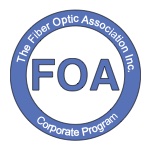 Corporate Memberships Corporate Memberships
FOA is now offering corporate memberships to companies involved in fiber optics as manufacturers, contractors, installers, etc. Among other benefits, Corporate Membership gives companies access to special FOA materials for educating customers and employees. Read more.
FOA Standards:
FOA has joined the American National Standards Institute (ANSI) to be able to keep up to date on more standards activities.
FOA now offers free standards for testing the installed fiber optic cable plant, patchcords and cable, optical power from transmitters or at receivers and OTDR testing. Look for the "1 PageStandard" web page and in the FOA Online Reference Guide.
Go to the FOA "1 Page Standards"
Free For FOA Members: NECA/FOA 301 Fiber Optic Installation Standard
Because of its importance to users, contractors and installers of fiber optic networks, The FOA and NECA have agreed to make the NECA/FOA 301 Fiber Optic Installation Standard available free to FOA members. It's specifically written to be used in contracts to define "installation in a neat and workmanlike manner." FOA members can go here for instructions on how to download your free copy.
FOA is a member of:


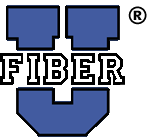
Three New Free Fiber U Self-Study Programs on Testing, Design and FTTx
There are two new free online self-study programs on Fiber U. Fiber Optic Network Design is for those interested in learning more about how ot design fiber optic networks or studying for the CFOS/D certification. FTTx is for those wanting to know more about fiber to the "x" - curb, home, wireless, etc. - or studying for the CFOS/H certification.
Got to Fiber U for more information.
We are considering using these self-study courses as part of online instructor-led courses using Linked-In. We have a new LinkedIn group, "Fiber Optic Training" (see below) which will be used for this. Join now for these courses.
- Reference Books for FOA Certifications are now available on Kindle and iPad/iPhone
  
We have created three new FOA books to be used in training for FOA certifications and as reference books for contractors, installers and end users of fiber optics. These books have full curriculum support, including free curriculum materials for teaching FOA certification courses. Because we are self-publishing these books using more modern "publish on demand" technology, they are easier to keep up to date, easier to buy and much, MUCH cheaper!
All are now available in print and electronically in Kindle and Apple iBook versions. The basic fiber optic book is also available as a self-study program in an Apple APP for iPad/iPhone/iPod.
Details on the new book each of the new books are at the book pages linked to the photos above.
FOA iPad Apps
The FOA has just released its second APP for the iPad, a free "loss budget calculator," FOA LossCalc.
FOA LossCalc
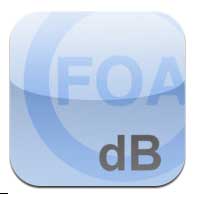 FOA LossCalc estimates the optical loss of a fiber optic link. This will save time for the installer of a fiber optic link needing to know whether test results are reasonable and/or make a "pass/fail" determination. It can also help the designer of a link to determine if communications equipment will operate over this link. FOA LossCalc estimates the optical loss of a fiber optic link. This will save time for the installer of a fiber optic link needing to know whether test results are reasonable and/or make a "pass/fail" determination. It can also help the designer of a link to determine if communications equipment will operate over this link.
By choosing the type of link (singlemode or multimode) and specifying the length of the fiber and numbers of connections and splices, it will calculate the end to end loss of the link. The app has default specifications for singlemode and multimode links or the user may create custom setups with specifications appropriate for any application. http://itunes.apple.com/us/app/foa-losscalc/id476262894?mt=8&ls=1
Self -Study in Fiber Optics
 Our first app is a self-study version of the FOA Reference Guide to Fiber Optics. The FOA APP builds on the FOA basic fiber optic textbook to create an interactive learning environment that builds on the iBook electronic version of the book to add a guide to use for self-study and real-time testing that provides feedback on what you have learned and correct answers to questions answered incorrectly. Our first app is a self-study version of the FOA Reference Guide to Fiber Optics. The FOA APP builds on the FOA basic fiber optic textbook to create an interactive learning environment that builds on the iBook electronic version of the book to add a guide to use for self-study and real-time testing that provides feedback on what you have learned and correct answers to questions answered incorrectly.
The FOA APP is priced at only $9.99, same as the iBook, so the self-study program is free. Download it from the Apple APP Store with your iPad or iTunes.
http://itunes.apple.com/us/app/foa-guide/id434354283?mt=8&ign-mpt=uo%3D4
NECA/FOA 301 Installation Updated
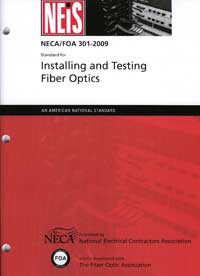
Standards cover components and systems and how to test them, but rarely get into installation issues. The FOA NECA 301 standard which covers installation of optical fiber systems has been revised for the second time, adding considerable new materials. This standard is derived from FOA educational material put in standards form and approved by ANSI as an American National Standard. It's specifically written to be used in contracts to define "installation in a neat and workmanlike manner." The standard is available from NECA. FOA members can go here for instructions on how to download your free copy.

New FOA Lectures
We've added a lecture on a new topic, the characterization of optical fibers for CD, PMD and spectral attenuation, important issues for long haul systems and DWDM.
FOA Lecture 28, Fiber Characterization
We also added a Premises Cabling lecture on counterfeit Cat 5 cable, with a demonstration of its flammability.
Premises Cabling Lecture 11: Counterfeit Cat 5 Cabling
2 New "Hands-On Hints" Videos:
Using an OTDR
Visual Inspection of Connectors With A Microscope
Below is a list of all the current lectures (plus there are 28 hands-on videos too!). We're looking for ideas for topics for future lectures. Send your ideas to <info@thefoa.org>.
Hands-On Fiber Optic Videos show how it's actually done
Using an OTDR
Visual Inspection of Connectors With A Microscope
Fiber Optic Connector Polishing Technique
The Fiber Optic Tester In Your Pocket (Cell Phone)
Insertion Loss Testing
Fusion Splicing
Mechanical Splicing
Fiber Optic Termination, Part 1, Setup & Tools
Fiber Optic Termination, Part 2, Jacketed Cable Prep
Fiber Optic Termination, Part 3, Adhesive Prep
Fiber Optic Termination, Part 4, Stripping Fiber
Fiber Optic Termination, Part 5, Connector Attachment
Fiber Optic Termination, Part 6, Polishing
Fiber Optic Termination, Part 7, Inspection
Fiber Optic Termination, Part 8, Distribution Cable Termination
Fiber Optic Cable, Part 1 Introduction
Fiber Optic Cable, Part 2, Zipcord
Fiber Optic Cable, Part 3 Distribution Cable
Fiber Optic Cable, Part 4 Breakout Cable
Fiber Optic Cable, Part 5 Loose Tube Cable
Fiber Optic Cable, Part 6, Armored Cable
Lectures On Premises Cabling
The FOA has added 10 more videos to our YouTube Channel, thefoainc. These are an introduction to premises cabling, covering applications, types of cabling, standards and installation practices for copper (UTP and coax), fiber and wireless. Like our lecture series on fiber optics, these provide a comprehensive introduction to the subject in short videos, typically 5-10 minutes in length, on each subject. Watch for more.
Premises Cabling Lectures on YouTube
"Hands-On" UTP Cabling Videos show how it's actually done
UTP "Cat 5" Cabling, Part 1, Tools
UTP "Cat 5" Cabling, Part 2, The Training Board
UTP "Cat 5" Cabling, Part 3, UTP Cable
UTP "Cat 5" Cabling, Part 4, 66 Block Punchdown
UTP "Cat 5" Cabling, Part 5, 110 Block Punchdown
UTP "Cat 5" Cabling, Part 6, Jacks
UTP "Cat 5" Cabling, Part 7, Testing
UTP "Cat 5" Cabling, Part 8, Plugs and Patchcords
View all the FOA YouTube video Lectures.
What's New in the FOA Online Fiber Optic Reference Guide
We have been updating the Online Reference Guide to keep up with changes in the industry and adding lots of new pages of technical information.
FTTx and Design Pages Updated
As we developed the new Fiber U self-study courses, we updated the FTTx and Design pages and added a FTTx installation section.
Testing FTTH
Basic guidelines for testing FTTH PON networks
Learn More About OTDRs - Download a Free OTDR Simulator
More and more installers are being asked for OTDR testing but using these instruments is not easy. They are hard to set up properly and complicated to interpret the traces. Using the autotest function can lead to disastrous results! The FOA has a good tutorial on OTDRs on our Online Reference Guide and we added a free download of an OTDR simulator to the OTDR section so you can learn how to use an OTDR on your PC.
More New Info:
Links to manufacturers and distributors of fiber optic lighting products.
The FOA Online Fiber Optic Reference Guide has become very popular - perhaps the most popular technical website ever, typically with over 360,000 users downloading about 1.75 million pages in 2011! We continue updating materials regularly, keeping it as up to date as possible.
Find What You Want Using "Google Custom Search
 There's so much information on the FOA Tech Topics and Online Fiber Optic Reference Guide that even a well-organized Table of Contents isn't enough and when the material is always changing, an index is impossible to maintain. So the FOA is using the latest technology in search, Google Custom Search, which will allow you to search just the FOA Tech Topics and Online Fiber Optic Reference Guide for any topic you want to find more about. Try it! There's so much information on the FOA Tech Topics and Online Fiber Optic Reference Guide that even a well-organized Table of Contents isn't enough and when the material is always changing, an index is impossible to maintain. So the FOA is using the latest technology in search, Google Custom Search, which will allow you to search just the FOA Tech Topics and Online Fiber Optic Reference Guide for any topic you want to find more about. Try it!
Go to The FOA Online Fiber Optic Reference Guide.
School News
Quote from one of our certified instructors: I want to thank you and your organization for all the resources you provide for the students and the opportunity to offer the certification to the students. The fact that you published the book yourself to get the cost down and the unlimited free resources on your website shows a commitment to the public that is second to none. I let it be known to the students that the FOA is the best in the industry at supplying knowledge and resources related to the communication industry. I look forward to passing on the information that you provide for the industry.
New Schools
The FOA welcomes the newest additions to our listing of FOA-Approved Training Organizations:
NY Transit Authority, FOA-Approved School #328
Consultronica, FOA-Approved School #755
Find a listing of all the FOA-Approved schools here.
It's Now A Lot Easier To Find A FOA-Approved Training Organization

Most phone calls we get regarding finding a FOA-Approved training organization want to know two things: what school is closest to me or what school offers the certifications I need. That can be difficult, since the FOA has almost 200 training organizations we have approved worldwide!
We've been looking at ways to make it easier, and we think we've got a good solution. In fact we have two solutions.
First we have added a sortable table of all the FOA-Approved schools.
You can also use our FOA Google Map Application to find FOA-Approved schools.
Here are links to the sortable table of all the FOA-Approved schools and FOA Google Map.
What Should A Fiber Optics or Cabling Tech Know and What Skills Do They Need?
The FOA has been updating its lists of KSAs (Knowledge, Skills, Abilities) for fiber and cabling techs. The updated list is now on the website for your information and comments - as fiber and cabling KSAs evolve as new technologies develop.
KSAs for fiber and cabling techs.
Good Question! Tech Questions/Comments Worth Repeating
Tech Hint: Did You Know You Have A Fiber Optic Tester In Your Pocket?
Yes! The camera in your cell phone is sensitive to infrared light - lots more than your eye - and can detect light in an optical fiber or from a transmitter. Chris Hillyer,CFOT/CFOS/I, Master Instructor, Northern California Sound & Communication JATC sent us some photos showing how this works. See below or the video now on YouTube. Update: You should check out your old cell phones before you recycle them. We've found older models use sensors which are better at infrared than the newer ones which take better pictures. This is a good use for your old cell phones hiding in the drawer!
Multimode Fiber Types, Testing
Q: What is the difference between OM2, OM3 and OM4 fiber? What equipment is best suitable to test these kind of cables for errors?
A: The difference in OM2/OM3/OM4 fibers is the bandwidth capability of the fiber. For a 10G network, OM3/OM4 is recommended. OM2 is NOT recommended. We recommend that patchcords be the same fiber type. At 10G, the loss of the cable plant must be quite low, <2dB. Higher loss will cause receivers to have higher bit error rate (BER) which results in retransmission of packets and lower throughput.
Cables should be tested for loss and all connectors inspected and cleaned thoroughly. Dirt can cause reflections at connections that also cause high BER. So you need a insertion loss test set (light source and power meter) with microscope.
Cleaning For High Power Systems
Q: Are there any documents that discuss how to clean fibers in high power DWDM/fiber amplifier systems?
A: The problem with dirt on high power fiber optic systems has been known for ages. When fiber was first used for industrial cutting and laser surgery systems, the users found that dirt on the end of the fiber would practically explode, causing pits in the end of the fiber and eventually ruining it. Our first encounter with this was with industrial cutting systems which used metallic connectors. If you are not finding materials specific to high power systems, I'd bet it's because DWDM systems are the norm today and the CATV industry has dealt with high power for a decade. Telcos tell us they prefer to add wavelengths to current fibers rather than turn up new fibers because it's cheaper and easier. Thus all cleaning is intended for these systems.
More on cleaning.
Gainers
Q: I understand that gainers can result from differences in core diameters and mode field diameters. My understanding is that a larger core diameter after a splice can create a gainer, due to increased scattering from the increased CSA. This would imply the same relationship for MFDs. Do you have a source that presents an explanation of the splice loss with differing MFDs?
A: MM fiber works on "geometric optics" or "classical optics" while SM fiber works on "quantum mechanics!" When you reduce the size of the optics to a small multiple of the wavelength of the light, strange things start happening. In SM fiber, the light actually travels outside the geometric core - depressed cladding fibers have been used to help confine the light in the core- and it's a significant amount - and it's dependent on the wavelength of the light, so more light travels outside the "core" at 1550 than 1310.
One way of explaining why a fiber with larger MFD has more loss is this: consider the cross section of the fiber. If the light travels in a larger spot size, the cross section for scattering is larger so one should expect there would be more scattering in the fiber with a larger MFD.
Standard Power Levels For Multimode Fiber Systems
Q: I have been trying to find a standard for the transmit power of multi-mode 1310nm optics. Is there such a standard? I see most fall within the -14 to -20 range, but I haven’t been able to find any definitive standard.
A: There are standards but they apply to communications systems, not general fiber optics. See http://www.thefoa.org/tech/Linkspec.htm which shows the distance and loss ranges, but not the power. That is specified in each of the systems specs, but, for example, the Ethernet standards that include "L" in the name are long wavelength (1300nm) systems.
Multimode systems may have either LED or laser sources at 1310nm, so the power can vary from around 0dBm for 1310nm fabry-perot lasers (1000base-LX) to the range you mention (-14 to -20 dBm) for 1300 nm LEDs.
As a transmission wavelength for multimode, 1300nm is becoming less used. While the attenuation of multimode fiber is less at 1300nm, the fiber bandwidth is optimized for cheap 850 nm lasers (VCSELs) so the bandwidth is poor at 1300nm, leaving that wavelength to mostly long, slow systems. Furthermore, singlemode is now easier to use and the fiber much cheaper, so many if not most 1300nm links are singlemode, even in premises applications.
Replacing Connectors On OTDR Launch Cables (6/12)
Q: I just got some brand new launch and receive fiber cables for my OTDR and the connector on one end went bad for some reason. Can I replace it myself?
A: The connector on your launch and receive cables need to be good, since bad ones will always show high loss when connected - even to good connectors. It is hard to do a field connection that is as good as the factory polished connections on the original cable. We recommend replacing the original connectors by fusion splicing a new pigtail on the cable if the connector is too badly damaged to repair, as the fusion splice will only be a few hundredths of a dB loss. (there are new unicam-like connectors that are susion- not mechancial spliced) You can also repolish the connector using diamond film which will polish the ceramic ferrule as well as the glass and remove enough material to remove scratches.
Another field trick is to reverse the cable and put the bad connector on the OTDR end. One of the FOA Master Instructors is the guy who wrote and taught the OTDR trainng for AT&T and he recommends using a short (3-5m) cable on the OTDR which is never removed to protect the OTDR connector then attache the launch cable to it, so even a bad connector on the cable will not harm the one on the OTDR.
More on Loss Budgets (4/12)
Q: We manufacture cables for seismic industry which contains fiber optics. I have some questions after checking your loss budget document at http://www.thefoa.org/tech/lossbudg.htm.
a-If we want to establish the specs for max allowed attenuation for a cable containing 1 connector at each end (meaning the cable has 2 connectors); is it correct to calculate it this way: 2 x (0.75 db “TIA-568 max) + fiber loss along the length = our loss budget ?
b-What about the connectors of the optical power meter used for measuring (the ones we mate with each connector at end to transmit/receive the light)? Should I add their connector loss in the budget or I assume that the connector mate loss = max loss between one of both connectors (assuming the one at the cable has higher loss) for each end?
A: Let's start with question "b", testing. For reference, I'm going to use the new FOA standard for testing the cable plant: FOA Standard FOA-1
I am assuming the connectors on the cable are compatible with the meter, e.g. some version of the SC/ST/FC family with 2.5 mm ferrules and you have some compatible launch and receive cables that have been tested and are known good.
When you do a reference calibration in the one cable reference method, you attach the launch cable to the source (leave it attached for the duration of the testing) and the other end to the meter input to do the "0 dB" calibration. Most meters have an adapter that screws on top of the actual detector of the meter so the end of the fiber faces the detector. This interface is not without some loss, but it is consistent in the coupling of the power from the fiber to the detector of the meter, so it is a constant in the measurement.
Now we know how much power is exiting the fiber of the launch cable. To test a cable, we attach the cable we want to test to the launch cable. That connection has loss that depends on the quality of the connectors on each cable and the alignment precision of the mating adapter for the connectors.
If we attached the other end of the cable we are testing to the meter now, we would measure the loss of the connection to the launch cable and the loss due to the attenuation of the fiber in the cable. Since the connector mated to the meter has the same interface as the reference cable when we calibrated "0 dB" there is no loss added in this connection. We use this test for patchcords since it allows us to test each connector independently by reversing the cable and thus we can identify if we have one bad connector.
Completed cable assemblies are usually tested double ended, so on the opposite end from the launch, we attach a receive cable. The connection to the cable under test is added to the loss we measure and the connection to the meter is the same as for all other measurements so it is not included.
Thus the loss budget adds the connections on each end of the cable to the fiber loss since that is what is measured in this test.
Now we did this test with what we call a "1 cable reference" but there are options for 2 or three cable references. The standard linked above shows why you might use a 2 or 3 cable reference, it's a matter of the connectors on the cable and the meter and how they can be mated. What confuses people is what you are actually measuring with the 2 or 3 cable reference, since connections are included in the setting of the "0 dB" reference. We have a web page that explains the math: http://www.thefoa.org/tech/ref/testing/5ways/lossmath.html
In our loss budget calculations, we always include the loss of the connectors on each end since most tests are done with a 1 cable reference. If you use a two cable reference, the loss is reduced by the amount of loss in the connection(s) during the setting of the 0 dB reference, plus the measurement uncertainty is increased due to the uncertainty of the loss included in the reference. We address the measurement uncertainty here: http://www.thefoa.org/tech/ref/testing/5ways/fiveways.html
Now question "a": The answer is "yes" with a caveat. That is how you calculate the loss budget. Most connectors do not have 0.75 dB loss! That number has been used in TIA and ISO/IEC standards for many years. It was created by manufacturers as a worst case value for them to use so that all types of connectors would meet the standards. In fact, the more typical values for loss are ~0.3 dB for adhesive polish connectors, ~0.5-0.75 dB for prepolished/splice connectors and ~0.75 dB or more for multifiber connectors.
So while 0.75 dB is in the standard and widely used, you may want to use a lower value more representative of the manufacturing process.
Burying Fiber Ducts Below Frost Line (3/12)
Q: Should fiber ducts in northern regions be laid below frost line. Frost line in some areas of Canada is typically 8 feet.
A: Normally telecommunication conduit should be place below frost line when ever possible. Cost is always a factor, in most cases frost line does not exceed 36" (1 meter aprox). Northern Canada is an exception. Depending on the strength of the conduit/cables to resist the crushing force of ice frozen in place around cables (see manufacturer). Ice has been know separate conduits from itself, frost has crush conduits/cables. The following designs have been used:
1) Use schedule 80 conduit/ GIP conduit (threaded pipe).
2) Design each conduit section so that it will drain down hill.
3) Keep water out off handholes/manholes. This can be very difficult & costly.
4) Ensure that cables can maintain frost crushing (see manufacturer).
Companies like Bell /AT&T have been placing conduit below or at 3' to 5' in Canada.
Companies like CATV have been placing conduit below or at 2' to 4' in Canada.
In the US most conduits are placed 24" to 60" for communication.
Each situation will need to be reviewed on a case by case bases.
Municipal Fiber Network Advice (2/12)
Q: I am charged with researching a municipal requirement to install fiber optic infrastructure in new development--this could either be for active development or dark fiber for future connection. Any pointers as to where to look? Have any communities done this well.... done this poorly.... have good examples of policy, legal code or standards?
A: Municipal networks are becoming very common. The best example I know is Santa Monica, CA Citynet http://www.smgov.net/departments/isd/smcitynet.aspx and we've interviewed them on the project.
Santa Monica built a citywide network to combine connections to all the city offices, public safety offices, libraries, etc. plus added numerous CCTV surveillance cameras, smart traffic signals and muni WiFi. They installed lots of fiber - fiber is cheap but installation can be costly, so they built a big network with lots of dark fiber in the beginning. Then they leased fiber to the local CATV company, Verizon for FiOS fiber to the home, and connected up dozens of tech companies to high speed Internet access (Google, Yahoo and dozens of movie production houses are located in Santa Monica.)
The really good deal was it paid for itself. Federal money helped with the initial installation (DoTransportation, DoEducation, Homeland Security) and leased fiber keeps the income coming.
As a big college town already involved with "Gig U" (http://www.gig-u.org/), you should contact the people at the University to see what they have planned that may be able to be combined with your work.
I suspect that every town has its own issues with policy, codes and standards. We've discussed some of the issues with other towns and one thing that comes up regularly is that at a minimum, the town should own the conduits even if the fiber is private. If a private contractor digs up the streets to bury cables they should be required to install many conduits for whenever another company wants to pull cable, the conduit is ready and no digging will be necessary. We also suggest talking to the local telephone and CATV companies. In the past, many have fought muni fiber but now many cooperate with the city and lease fiber from them.
Help On Termination 2/12
Q: I'm working as an user and sometime I install connectors on fibers. Most of the time I work with ST connectors. Do you have a small guide how to prepare, and polish the fibers ? Is it possible to use ST single mode connector on Multimode fiber and viceversa ?
A: We have several links that help you:
YouTube Videos:http://www.youtube.com/playlist?list=PL21F27A040DFAA6E5&feature=plcp
Tutorial: http://www.thefoa.org/tech/ref/termination/Term/Term.htm
Step-By Step Virtual Hands-on Termination: Epoxy/Polish, Anaerobic, Hot Melt
Singlemode fiber termination, Hands-on SM termination
Even more from the FOA Online Reference Guide: http://www.thefoa.org/tech/ref/contents.html#Components
Singlemode connectors have tighter tolerances and a slightly smaller hole in the ferrule. Generally speaking, you can use SM connectors on MM fiber, except when the fiber diameter is on the high side of tolerance but you should never use MM connectors on SM fiber as the fit will be sloppy and the resulting core offset causes high loss.
Removing Unused Cables 2/12
Q: Can you point me in the direction of information on how to properly and safely remove 50 Micron Multi-mode Fibre Optic Cable from a data center? My company would like to remove their old FOC when they upgrade to 10g cable fibre and were considering cutting the LC connectors off the cables to make it easier to pull through the rats nest of cables under the floor. Is this a safe method?
A: There is not standard way to remove cables, as it will depend on the installation. Cables in underfloor (or overhead) trays tend to be enmeshed in other cables unless they are in separate ducts. Under any circumstances, the best way to remove them is to cut off connectors, locate the cables and cut into lengths that are easily removed (just make sure you are cutting the right cables - a installer doing this with some cables in Newark, NJ once cut the wrong cable and put Wall St. out of business for a day!). Once they are cut into short lengths, it should be easy to remove them.
After removal, the cable can be recycled for the plastic - connectors are trash. Or if they are long enough, I may know some schools who would like them for their hands-on labs!
Higher Loss At Long Wavelengths? 1/12
Q: I have a tech in the field that has installed a piece of single mode fiber approx. 650’ long. He is testing it with a source and meter. The fiber is passing the 1310 loss test but failing the 1550 test. What could be causing this? He has put new ends on the fiber already and is getting the same results.
A: This sounds like a classic problem of cable stress. Singlemode fiber is much more sensitive to bending stress losses at 1550nm than 1310nm. If there is a stressed area in the cable installation, it's easy to get >3dB loss from a tight bend or kink, even near the connectors. There should be no difference with the connectors themselves. Telcos test links at 1625nm for stress testing.
Followup: The tech went back to the job site with an OTDR and found there was a spike in the reading about 120’ from one end which is where there is a pull box up in the ceiling.
Fiber Cleaning
This is a topic we keep reminding everybody about, and here is why:
From a contrator in the Middle East: Here some samples of the connectors for SM fiber already installed in the system we were testing.
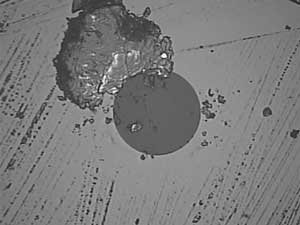 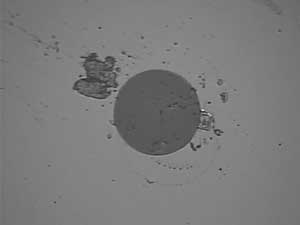
As you can see, the dirt is large compared to the size of the fiber (dark gray), and the core (not visible here) is only 9/125 of the overall diameter of the fiber! More on cleaning. See Product News below for links to vendors of fiber cleaning products.
See news about Fiber Optic Cleaning Videos on YouTube by ITW Chemtronics below.
Measurement Uncertainty: Everyone testing fiber optics should understand that every measurement has some uncertainty - whether you are measuring loss, length, wavelength, power, etc. Knowing that uncertainty is very important to interpreting the measurement. It's worthwhile to read and understand the issue of measurement accuracy covered in this page of the FOA Online Fiber Optic Reference Guide.
Worth Reading or Watching:
Recap: Recent FOA Newsletter Articles You Might Have Missed
Where Are The Jobs In Fiber Optics?
The August, 2012 FOA Newsletter presented a review of where we see the most active areas in fiber optics now and where the jobs seem to be most available. You can read this article here. If you are looking for a job, the FOA also has a web page on looking for jobs and a LinkedIn group for CFOTs where jobs can be posted,plus a jobs section in this newsletter.
FTTO: Fiber To The Office
At our seminars in the UAE with eSharp Consultancy, Cliff Walker presented information on his work designing "fiber to the office (FTTO) networks. The concept is based on using fiber to connect large switches in the equipment room to smaller switches with 4 ports at the outlet. You can read Cliff's paper on the airport system to see estimates of the cost savings using FTTO.
Read Cliff Walkers paper on FTTO.
More On Fiber Use In Wind And Solar Power
Craig Bowden, FOA Master Instructor at FiberNexxt in NH, presented a program at the New England Fiberoptic Council recently on fiber in wind power. His presentation is available for downloading here. It's full of good illustrations and photos that tell the story.
Jonard FOD 2000 Fiber Optic Drop Cable Slitter
The FOD-2000 Fiber Optic Drop Cable Slitter is a patent pending tool that simplifies the slitting of drop cable jackets at the end of the cable or mid-span. For Flat Cables. Wathc their YouTube Video: http://www.youtube.com/watch?v=B1H2zrW3k34
Making Sense of The G.657 Standard (OFS)
The G.657 standard was developed by the International Telecommunications Union (ITU) to provide consistency in the evolving requirements for bend-insensitive single-mode fiber.This OFS paper sums up the standard and what it means. Read more.
What's ahead for multimode fiber communication systems?
By Gastón E. Tudury, Ph.D., and Al Brunsting, Ph.D., Panduit
With networks like Ethernet moving to 40 and 100 Gb/s, current multimode fiber has been forced to a parallel optics solution, not considered acceptable by some users like Google, due to the masses of fiber needed for data centers. Rather than go to a singlemode WDM solution, these two suggest we should look at redesigning MM fiber, cutting the NA for higher bandwidth and maybe tweaking the VCSELs too. Lightwave.
In Pictures: The World’s Largest Solar Thermal Power Plant
BrightSource’s 370-megawatt facility near Las Vegas is taking shape, with lots of fiber optics being installed by FOA-certified techs..
http://www.technologyreview.com/news/428009/in-pictures-the-worlds-largest-solar-thermal/
Want To Know Where Submarine Fiber Optic Cables Run?
There is a good map online by TeleGeography you can access here.
Choosing the right connector: APC vs. UPC
An interesting article from ADC on the differences in APC and UPC connectors makes the choice easier. Read more.
Confused By Standards?
You are not the only one! As Bob Metcalfe, co-inventor of Ethernet, once said at a conference "The wonderful thing about standards is we have so many to choose from!" But the Siemon Company, an active participant in standards activities for decades, has tried to give some order to this chaos with a new website Standards Informant where they cover the TIA, ISO /IEC and IEEE standards that affect cabling and networks. If you need to keep up with standards, sign up for their email newsletter too.
Patchcords: You Get What You Pay For Says Siemon
Siemon is a global manufacturer of cabling products that has been a big contributor to international standards. Recently they tested patchcords procured from several sources and found out what you might expect - quality suppliers produced quality products but cheap suppliers supplied, well, you can read it here: http://www.siemon.com/go/fiberjumper
Benchmarking Fusion Splicing And Selecting Singlemode Fiber
We've been asked many times "How long does it take to splice a cable?" It's not a simple answer as it varies with the number of fibers in the cable and the work setup, including whether one or two techs are working at a job site. FOA Master Instructor Joe Botha of Triple Play in South Africa did his own analysis based on decades of experience both splicing cables and teaching others how to do it properly. This is one of the best analyses we have seen because Joe includes prep times as well as splicing times and differentiates between one tech and two techs working together. He adds some other tips on fusion splicing too. This should be mandatory reading for every tech and given to every student! Here is Joe's splicing analysis.
Joe also has an excellent writeup on how to choose singlemode fiber that helps understanding the different types of G.6xx fiber. Read it here.
And you will want to read Joe's report on splicing different types of SM fiber, including bend-insensitive (G.657) fiber. Read it here.
Videos on Firestopping: These free videos from UL and the International Firestop Council are good tutorials on firestopping. Go here to view the videos.
Micro-Trenching, Cable Removal (3/12)
Nano-Trench offers products for micro (or I guess they call it nano-) trenching and their website is very informative. They also have Kabel-X, a method of extracting copper cables from old conduit. Both websites are informative and interesting. Watch this video on the cable removal process!
Free - Mike Holt's Explanation Of The US National Electrical Code (NEC) For Communications Cables
Mike Holt is the acknowledged expert of the US National Electrical Code (NEC). His books and seminars are highly praised for their ability to make a very complicated standard (that is in fact Code - law - in most areas of the US) easily understood. Part of the appeal is Mike's great drawings that make understanding so much easier. Mike makes Chapter 8 of his book available free. It covers communications cables, telephones, LANs, CATV and CCTV, for premises applications. Even if you live in a region or country where the NEC is not the law, you may find this interesting.
Download Mike's Chapter Here.
Fiber Optic Crossword Puzzles For Entertainment And As A CFOT Certification Study Aid (2/12)
Pearson Technologies Inc., a 32-year fiber optic training, technical and marketing consulting firm, announces availability of a free training and certification tool. This tool is a free set of crossword puzzles on the terms of fiber optic installation and products. This set assists those studying fiber optic installation or planning to take the Fiber Optic Association (FOA) Certified Fiber Optic Technician (CFOT) certification examination. The four puzzles are for: light and fiber terms, cable terms, connector and splice terms, optoelectronics and testing terms.
The puzzles can be viewed and printed from: http://www.ptnowire.com/resources.htm or http://www.ptnowire.com/CFOT-Puzzles-vb.pdf. Individuals can receive the answers by email request.
For additional information, contact Pearson Technologies Inc. at: 4671 Hickory Bend Drive, Acworth, GA 30102, at (770) 490-991, or via e-mail at fiberguru@ptnowire.com.
New Eric Pearson Books
A new book from Eric Pearson, Mastering Fiber Optic Network Design, has just been introduced (9/12).
  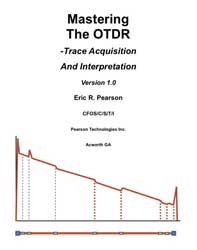
Pearson Technologies Inc. announces the release of four new books, Mastering Fiber Optic Network Design, Professional Fiber Optic Installation, The Essentials For Success, Mastering Fiber Optic Connector Installation and Mastering The OTDR.
Based on 32 years of experience, laboratory testing, development, and training of more than 8000 installers, these books is suitable for training, installation, personnel certification, and reference. Eric's books are perhaps best described as fiber optic "cookbooks," full of detailed directions that reflect many years of tesing in his courses. They are valuable references for the fiber optic tech.
For additional information. contact Pearson Technologies Inc., www.ptnowire.com, fiberguru@ptnowire.com, 770-490-9991
Fiber Optic Cleaning Videos on YouTube
ITW Chemtronics has three fiber optic cleaning videos on  covering Dry Cleaning, Wet-Dry Method, FiberWash and Combination Cleaning. They are good explanations of cleaning processes - the Wet-Dry is especially interesting. covering Dry Cleaning, Wet-Dry Method, FiberWash and Combination Cleaning. They are good explanations of cleaning processes - the Wet-Dry is especially interesting.
A Documentary Treasure on the History of the Internet
15 minutes of a rarely-seen BBC documentary demolish the myth that ARPAnet was inspired by nuclear war, and explain the far more intriguing truth.
http://www.technologyreview.com/blog/mimssbits/26719/?nlid=4433
Ensuring Distance Accuracy On OTDR Measurements
By JDSU.
Broadband Properties Webinar Archives

Lots of interesting webinars, mostly on FTTH. Go here.
FTTX Networks
An ADC white paper on how they work and how networks are upgraded to FTTH. http://connectedplanetonline.com/images/CP-ADC3-WhitePaper-v4.pdf.
JDSU Application Note On "Qualifying FTTH Network before Equipment Installation"
Another great paper from JDSU covering FTTH PON networks is available for downloading. It gives an overview of FTTH architecture, cleaning connectors then testing the cable plant with OTDRs and OLTSs. This paper will help you understand why OTDRs can be confusing on PONs!
Best Practices For Wireless Backhaul Network Upgrades
Joan Engebretson, Contributing Editor of Connected Planet has written a very good overview of how fiber is essential to the operation of cellular wireless systems. Everybody probably knows that fiber is used to connect towers into the telecom network - they call it backhaul - but her article also covers the new appliations to replace bulky, heavy, lossy coax up the tower to the antennas. http://connectedplanetonline.com/images/CP_ADC2_WhitePaper.pdf.
Fiber Optic Safety Poster
We've had numerous requests to reprint our guidelines on safety when working with fiber optics, so we have created a "Safety Poster" for you to print and post in your classroom, worksite, etc. We suggest giving a copy to every student and installer.
Corning now offers videos on  . Lots of interesting videos, some technical, some sales, but all good information. . Lots of interesting videos, some technical, some sales, but all good information.
US Conec's videos on cleaning fibers - show's the results of proper cleaning.
Webinars of Interest
Broadcast Engineering Magazine - Fiber Optic Testing
FOA President Jim Hayes presents an overview of fiber optic testing for all applications. Available on Demand. Sign up here.
Multimode Fiber Trends from TIA's Fiber Optics LAN Section
Ryan Chappell, Draka Communications, looks at the evolution of multimode fiber, examines its current usage and shares predictionson its future Available on-demand at: http://www.brighttalk.com/webcast/7182/play
OSP Magazine Webinars
OSP Magazine (OSP as in outside plant telco) is now offering a number of interesting webinars that cover fiber topics, including network design and specialized components. http://www.ospmag.com/events/web/
Multimode Fiber Characterization Launch Condition Considerations - new ap note from JDSU
JDSU Reference Guide to Fiber Optic Testing – Volume 2 Published
The second volume of the JDSU series on fiber optic testing has been published. Volume 1 focused on Basic Fiber testing and Volume 2 is geared toward fiber optic installers, project managers, telecom technicians and engineers who need to understand fiber networks. Volume 2 also covers Chromatic Dispersion, Polarization Mode Dispersion, Attenuation Profile and Fiber Link and Network Characterization. A 3rd volume, a glossary of fiber optic terms, is also available for download.
This is a "MUST HAVE" for all fiber optic techs. Download your free copies here.
We used this book as one of our references in creating a new page in the FOA Online Reference Guide on chromatic dispersion (CD) and polarization-mode dispersion (PMD).
Careers in Fiber Optics: Brian Smith. A 1998 book on fiber optic jobs is a bit dated, but a free overview is on Google Books and worth a look at it online.
Dirt!
As much as 70% of the problems associated with deploying fiber to the home result from something as simple as dirty connectors according to JDSU. Telephony Online.
US Conec's videos on cleaning fibers - show's the results of proper cleaning.
Good Technical Websites
American Polywater (http://www.polywater.com/) has one of the best technical website for cable installers. Here is a rundown on some new material on their site.
Cable Installation using "Push" or "Push/Pull"
Polywater's new Pull-Planner™ 3000 Software allows a "pushing force" variable in pulling tension calculations. Read a White Paper that quantifies the push contribution and compares calculation results to field experience. --
http://www.polywater.com/pushing.pdf
Pulling Cable Through Water?
Read a Product Spotlight on Polywater® + Silicone™, Polywater's new generation underground lubricant. Continued reduction of friction when pulling through water is only one of the unique features of this lubricant. --
http://www.polywater.com/NNNBSL.pdf
Check out their website, especially “Videos,” “Engineer’s Corner” and “Calculators.” http://www.polywater.com/NNNBSL.pdf

" Heard on the Street" is a monthly online newsletter from Frank Bisbee of Communications Planning Corporation that covers the telecommunications and cabling businesses. Each month includes news from manufacturers, trade associations and professional societies like the FOA. You can read the current issue and back issues online.

JDSU has announced the See the Light webinar series, a four-part program designed for anyone involved in the installation, maintenance, and repair of fiber optic systems. It begins with fiber inspection and cleaning and then covers the basics of fiber testing. The webinar series then continues with the more advanced optical time-domain reflectometer (OTDR) and fiber local area network (LAN) testing challenges. More information on the series.
IGI is offering a series of webinars on topics of interest to those in the communications industry. You can join them live ir download from the archives. IGI WEBINAR ARCHIVES UP AND RUNNING - VISIT TELECOMBRIEFINGS.COM TO DOWNLOAD!
IGI, a major market research and technology reporting company (the "Active Optical Cables" below) is offering a a free one year subscription to one of our fiber optics newsletters to FOA members. All they have to do is to send IGI an e-mail stating which newsletter they would like to get. See http://www.igigroup.com/nl.html for a listing of IGI Newsletters.
-
- FOA Tech Topics -
A Fiber Optic Tester In Your Pocket? (See the video on  ) )
Yes! The camera in your cell phone is sensitive to infrared light - lots more than your eye - and can detect light in an optical fiber or from a transmitter. Chris Hillyer,CFOT/CFOS/I, Master Instructor, Northern California Sound & Communication JATC brought this to our attention.
 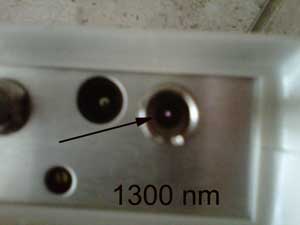
If you have an old cell phone, try it too. Our experience is that older cell phone cameras have better sensitivity at IR wavelengths than newer phones, so you may want to toss that old phone into the toolbox.
- FOA Technical Bulletins
- How do you design and manufacture fiber optic systems? Choose and install one to serve your communications needs? Troubleshoot problems? The FOA Fiber Optic Technical Bulletins will provide step-by-step guidelines to help you. All are PDF files you can download, print and use.
- Testing Update
- Are there really 5 different ways to test optical fiber cabling after installation? Why so many? How do the measurements - and more importantly the measurement results - differ? What are the advanteages and disadvantages of each method?
- Why are there 4 ways (maybe 5) to test fiber optic cables?
- Do OTDRs and OLTS tests give the same results?
-
- New Tech Topics
- Industry standards updated to include international standards
- Updated link specs for fiber optic networks - now includes 10/40/100G Ethernet.
Product News
Senko Connectors for Harsh Environments
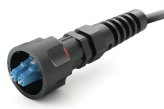
SENKO has introduced the IP-SERIES, an effective and low cost connector for harsh environmental applications. It withstands water immersion, dust and temperature ranges of -40 to +70C while providing low insertion loss. Available in LC, SC and MPO versions. Read More.
Handheld OTDR
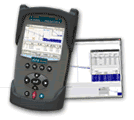
Advanced Fiber Solutions has introduced a new compact portable OTDR that offers high resolution (to 1m) and light weight (1.6 pounds, 0.72 kg) plus numerous wavelength and range options. Here is more information.
Magnetic Cable Management Hardware
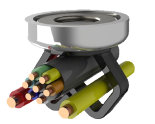
Mounting hardware for cable management in equipment or telecom rooms can be difficult - what do you attach things to? But RES has a unique idea - use magnets to hold the hardware on racks or any metal parts. Neat idea, see their products here.
Micro-Trenching, Cable Removal
Nano-Trench offers products for micro (or I guess they call it nano-) trenching and their website is very informative. They also have Kabel-X, a method of extracting copper cables from old conduit. Both websites are informative and interesting. Watch this video on the cable removal process!
Protecting Pedestals From Rodents
Pedestals and underground vaults can be damaged by rodents who come up through the base and damage cables. Uraseal "Drain N'Seal" foam deters mice from taking up residence in your pedestals. They have some good videos on using their product.
A Cable Tie That's Fiber Friendly
We're always warning installers not to tighten cable ties too tightly around fiber optic cable (or UTP copper cable either!) A better choice is the hook and loop fastener ties (Velcro is one trade name), but there is another type, the Mille-Tie. It's an open tie that can be used at any length, then cut off and the remainder used also. Take a look a the video to see how it works.
Mille-Tie Video: http://www.youtube.com/watch?v=QPVTQGKmcvE
Used Test Equipment – Buy or Sell
http://www.testequipmentconnection.com/
Have you read the FOA Tech Topics on Cleaning?
More links on cleaning:
Westover
- AFL
ITW Chemtronics
Cleantex Alco Pads
MicroCare
Seiko-Giken
-
- FTTH Notes:
Broadband Properties: Latest Issue has lots of FTTx News.
Google Map Shows Worldwide FTTx Projects
One of the better sites to track FTTx projects is this Google maps application that shows projects on a world map with details on the project.

Click on the map above or here to view the interactive web map.
Testing FTTH
JDSU shows how to test a PON with an OTDR: http://www.jdsu.com/other-literature/PON-OTDR_fop_an_ae.pdf
-
- Want To Learn More About FTTx?
- The FOA has created a special FTTx resources section of our website with a FTTx links page with lots of links to news, market reports, technical articles and vendor technical and product information. Here is a great place to start learning more about FTTx.
- FOA's CFxT FTTx Certification Program Explained
- Read the Broadband Properties article about the FOA FTTx certification program. Read the article about FOA President Jim Hayes being honored for his work promoting FTTH.
-
|

